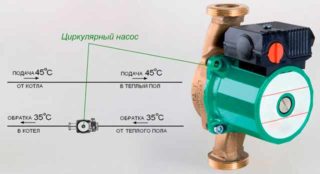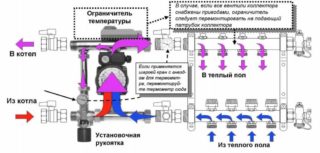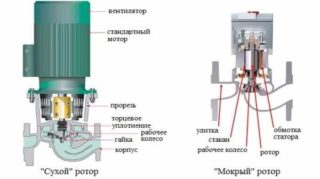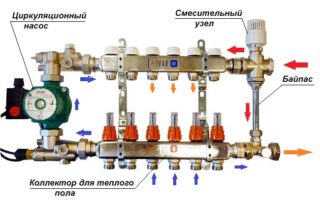To implement a warm floor system, a whole complex of elements is required. The total length of the floor pipeline can reach 120 meters, the diameter of the pipes - at least 20 mm in the presence of junctions and turns. In such conditions, hydraulic resistance is created, due to which water circulation is impossible without a pump.
Why do we need a pump for a warm floor
Laying the contour implies the presence of bends, because of which the natural flow of liquid is impossible. Heating of the heat carrier does not exceed a temperature of 40 degrees. All this affects the efficiency of the system - any violation leads to the formation of air jams. A pump is needed to solve this problem, although some homeowners are trying to save money by equipping heating without forced circulation.
The floor heating pump creates sufficient pressure in the system, dispersing water through the pipes. Natural circulation leads to heat loss.
Device and principle of operation
The device includes elements:
- housing;
- an engine equipped with an impeller and connected to the housing;
- parts for connecting parts.
Sometimes the pump is equipped with an air vent, but this is rare. More often they use a special nut - if you unscrew it, the air leaves the system on its own.
The principle of operation of the mechanism is simple: the fluid is sent to the housing, where, thanks to the rotation of the impeller, it is picked up and ejected further by pressure. Due to this process, forced circulation of water occurs.
In some pumps, 2 motors are installed - so the equipment will continue to circulate even at maximum loads. The second engine is connected if necessary and takes over part of the work. Also, the device is considered more reliable due to the reserve. However, equipment with 2 motors is more expensive and the owner will have to decide the reasonableness of such a purchase.
The pump is installed anywhere in the system — usually at the edge of the supply or return loop. It is recommended to individually select a place for installation of booster equipment. There are no special requirements - the operating temperature is not critical, but it will be more reasonable to install the device where it is lower.
Types of circulation pumps
- with a wet rotor;
- with a dry rotor.
Equipment for circulating water in warm floors is classified by power - it affects the characteristics of different pumps.
Wet rotor
The impeller is installed as close to the rotor as possible (often they are located in one housing) - this allows for compact equipment. To prevent fluid from penetrating the electronics, the drive shaft is equipped with an airtight rubber gland.
Often these pumps have double protection. Models with a wet rotor are small in size, so they are mounted directly in a warm room. They are virtually silent during operation.
The power allows water to be driven in the system for buildings with a total area of up to 400 m2. One of the popular wet rotor models that fits the specifications is Willo. These pumps are quite effective, but economically consume electricity, which reduces the cost of bills.
The small weight and dimensions allow installation directly on the pipes of the heating circuit without the presence of additional fasteners on the supports. All elements must be isolated to eliminate the risk of electric shock.If voltage drops occur, a built-in relay is used - it does not allow the mechanism to fail.
Dry rotor
Each structural part of the pump is located in a separate housing. A “dry” model of sufficient power will easily provide fluid circulation in the system to several apartments.
The equipment is large in size, so installation in a separate room is required. Due to the massiveness, a metal frame is required for fastening.
Dry models are very noisy at work, because they are rarely used in heating private homes. Such pumps are used at large enterprises or retail outlets.
An obstacle to using a dry rotor pump in a private house is often the fact that a three-phase mains with an internal voltage of 380 V is required for the model to function.
What parameters to choose
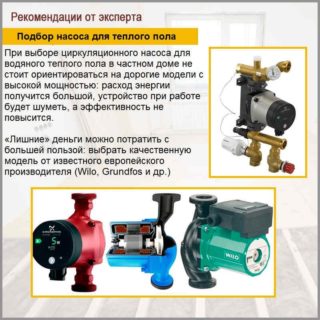 It is recommended to buy a pump complete with a warm floor, but if you have to buy equipment separately, you should pay attention to certain parameters:
It is recommended to buy a pump complete with a warm floor, but if you have to buy equipment separately, you should pay attention to certain parameters:
- Power. Measured in cubic meters or liters per hour. It should be 3 times the volume of circulating fluid in the system. Recommended performance - 25% above the set level (due to continuous operation, the equipment can quickly wear out).
- Ultimate pressure. The characteristic depends on the length of the pipeline, the diameter of the pipes and the material. If the pressure is not enough, the warm floor pump will overheat and will quickly fail.
- Dimensions A small model is easier to mount. However, the dimensions are far from the main thing, since compact pumps usually do not differ in power.
- Number of phases. A single-phase motor is enough for a private house. Three-phase devices are used for heating large buildings.
Before buying, you need to make calculations. A model with insufficient power will not drive the fluid as it should.
How to calculate the pump
 Attention must be paid to flow and pressure - productivity. The hydraulic resistance overcome by the pump is equal to the maximum pressure in the pipes, and the flow is 0.
Attention must be paid to flow and pressure - productivity. The hydraulic resistance overcome by the pump is equal to the maximum pressure in the pipes, and the flow is 0.
The selection of the model is based on the volume of the thermal carrier. Based on this, the hydraulic resistance is calculated. Heat loss is affected by:
- thermal conductivity of materials;
- fencing;
- finding the house relative to the cardinal points;
- temperature in the environment.
After calculating the flow rate of the coolant, it is necessary to determine the resistance parameter in the heated circuit. For this, standard tables are used. At the end, you can start choosing a model.
As an example, you can take a pump for a house with an area of 200 m2. Inside the equipment there is a two-pipe system of pipes with a diameter of 32 mm, length - 50 m, material - polypropylene, temperature chart - 70-90 degrees. Losses are 24 kW at a mass flow rate of 1.03 m3 / h. Further on the table, the hydraulic resistance is determined, in this case - 1.8 mbar / linear. m. For a length of 50 meters get 90 mbar. It is necessary to summarize with the resistance of the system parts, for example, 1 m will come out. As a result, the owner will need a capacity of 1.1 m3 / h with a pressure of 2 m. Based on the obtained parameters, you can purchase a device with sufficient characteristics.
Mounting Features
The pump is mounted between the three-way valve and the system manifold. Only then will the whole structure work. If you install equipment between the connection to the radiator network and the valve, the mixing unit will not be multifunctional, and heating will be ineffective.
The technique is fastened to the flanges using union nuts - they are delivered in a box. Installation usually does not cause difficulties if the eyeliner is properly equipped with sufficient distances.
Possible problems
The equipment works in the winter and does not cause problems, but in the summer the pump is idle. Hardness salts begin to be deposited in the system, especially in the casing.When the heating season begins, the engine activates, but the impeller does not spin due to blockage. A low-powered motor will not be able to crank it.
It is required to unscrew the nut - there will be a key cutout or a screwdriver. Further, you will have to manually turn the shaft with the impeller. The main thing is to slightly move the mechanism from its place, and then the motor will cope itself. If you still can’t cope, you will have to disassemble the box and clean the parts from deposits.
With the correct arrangement of the system and the purchase of a pump with the necessary characteristics, the operation of a warm floor will not cause difficulties.
